Oranda fish: features, types and content
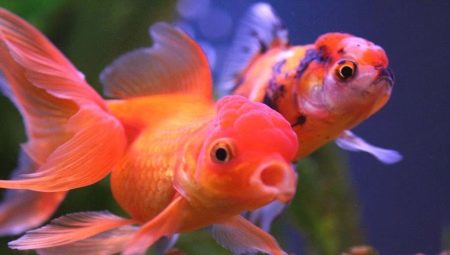
The life of a modern person is filled with a huge amount of trouble, bustle, problems and stress, which further and further alienate him from nature. In order to restore the emotional and psychological state after a working week, it is not necessary to go tens of kilometers outside the city, but you can create a living corner at home, the main element of which will be an aquarium. The aquarium and home ponds are unique designs that allow you to enjoy the inhabitants of the water depths without leaving your home.
In order to correctly fill a glass container, you need to seek help from professional aquarists, and all the required goods can be purchased in specialized stores that also sell algae and a wide range of fish. The beauty and harmony of the aquarium depends on the chosen aquatic inhabitants. Among the large number of fish species, experts recommend turning to one of the most beautiful - oranda.
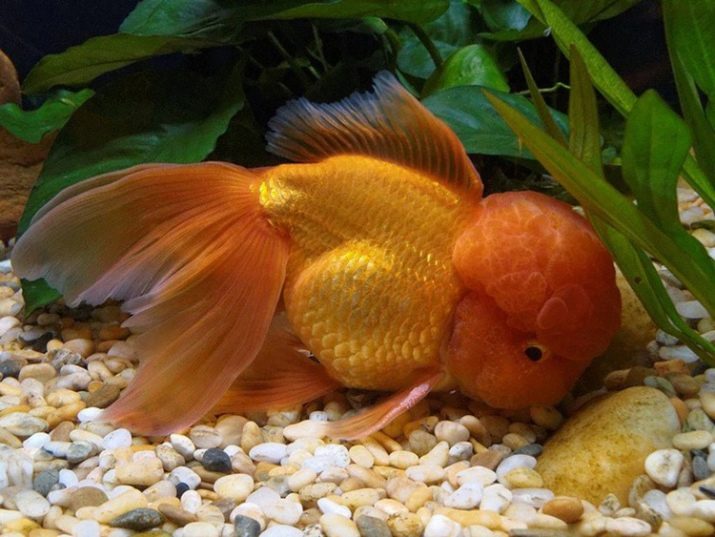
Description
Oranda is a very attractive species of aquarium goldfish from the carp family, which have bright fat build-ups on their heads. The homeland of Oranda is Japan. Back in the 15th century, the inhabitants of this country could enjoy the beauty of these fish. It was the Japanese who set the standard according to which the most valuable individuals should have the maximum number of bright formations on their heads. Such individuals should also have a tail in the form of a veil.
The average body length of the oranda is 19 cm, and the color has a wide color palette. The Hong Kong breeders managed to grow fish, the size of which was 40 cm. This case is an isolated and very rare one. Fish also show the presence of an unpaired dorsal fin and a long tail limb, the size of which can be 70% of the total body length. All fins are transparent and elongated. Males differ from females in their small size and the appearance of white spots during the spawning period.
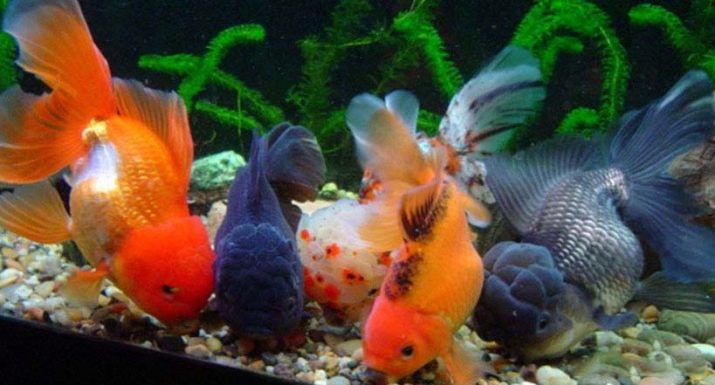
For a comfortable stay, the volume of the storage container should not be less than 100 liters. Experienced aquarists recommend purchasing this species in pairs. In addition, fish have additional features that are considered disadvantages in the field of aquaristics:
- undivided caudal fin;
- badly deployed fin on the back;
- asymmetrical top view.
In comfortable living conditions, the oranda will be able to delight its owners up to 30 years old. This elegant and unpretentious fish has a very shy character and does not tolerate being near aggressive species.
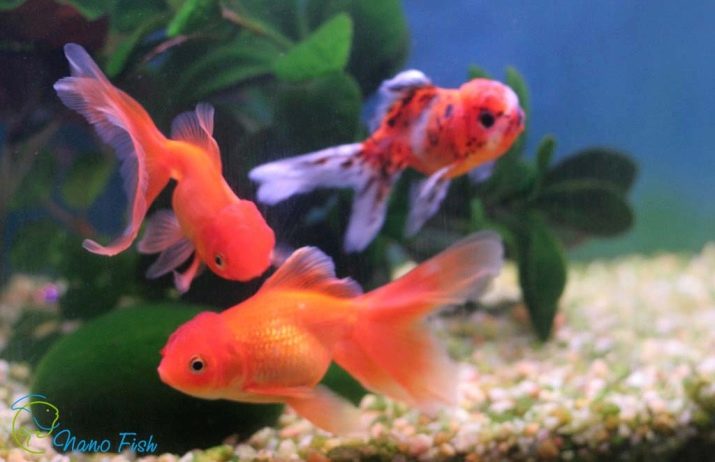
Varieties
This type of aquarium fish has several colors and varieties. Most popular oranda colors:
- saturated scarlet;
- gold;
- Orange;
- White;
- Brown;
- black;
- purple;
- motley;
- yellow.
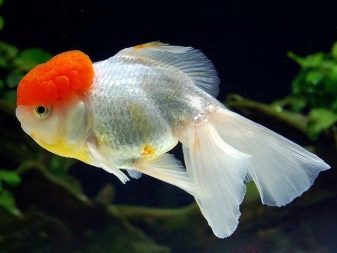
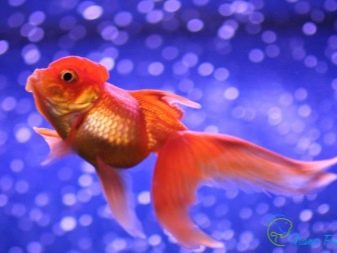
Novice hobbyists should pay attention to the following varieties of oranda.
- Pompom (gyroshima)... A beautiful subspecies that has fluffy growths on each side of the mouth. The size of these formations can be up to 1 cm. A distinctive feature of this type is the presence of a blue, red or white pom-pom at the tip of the nose. The length of the fish's rounded body can be up to 20 cm. There is no fin on the low back, and the caudal and anal fins are divided into two parts.
- Red and white. This is a striking kind of oranda. The body of the fish is covered with mixed red and white spots.
- Chocolate. The Chinese variety, in which the main color shade becomes brown, and the ebb of the scales is silvery. The body length can reach 25 cm. The color of the back and dorsal fin is always more intense and dark, and the surface of the head is colored in a dark chocolate shade. The short fins are rounded. This species belongs to the slow-floating ones.
- Blue. This oranda has a matte body shade and blue spots on the back. Newborn specimens retain all the breeding characteristics and characteristics of their parents.
- Gray. It is a dark gray species that has silver scales and dark head and fins. The surface of the head is covered with formations in the form of warts. Long fins have rounded ends.
- Chintz. One of the oldest subspecies, which was obtained by combining an oranda and a variegated telescope. The species has gained massive popularity only in the last few decades. Aquarists recommend growing gingerbread oranda in large home ponds and spacious aquariums. The body length of the fish does not exceed 20 cm.
- Red Dutch (lionhead). It is a fish that has a round and puffy body. The surface of the head is dotted with neat red formations that resemble a lion's mane. The caudal fin is small and bifurcated. This subspecies does not have a dorsal fin. A distinctive feature is the presence of bright red-lemon scales, the edges of which have a red border. The shade of the fins and tail is red.
- "Little Red Riding Hood". A white fish that has a large number of red growths on its head, resembling a headdress. Thanks to this feature and the combination of white and red, the aquatic animal has a spectacular and elegant appearance, as well as an egg-like body. The body length reaches 25 cm. There is a large fin on the back. The tail and anal limbs are distinguished by a long, bifurcated shape.

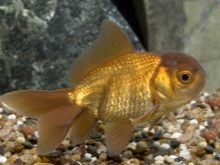
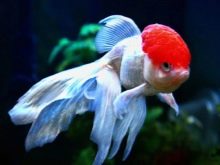
Despite the color variety, all species of this breed always have a contrasting growth on the head.If the conditions of detention are not observed, such a feature may disappear irrevocably.
Compatibility
To create comfortable living conditions for the oranda, it is not enough to properly arrange the aquarium. It is also necessary to carefully and carefully select her neighbors. A beautiful, graceful, elegant and non-conflict aquatic animal often becomes a victim of aggression from other inhabitants of the reservoir, who not only offend him, but also bite off beautiful fins.
Most unwanted neighbors:
- gurus;
- barbs;
- swordtails;
- mollies;
- cichlids;
- cockerels.
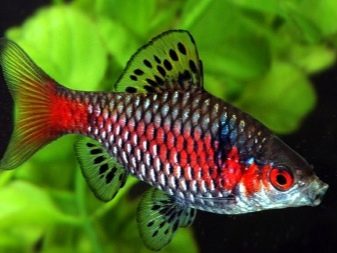
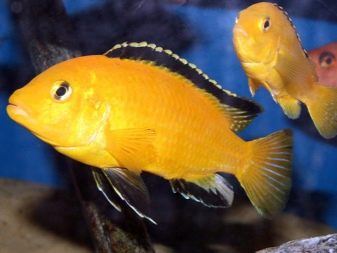
The following types of fish can become comfortable neighbors:
- ancistrus;
- pterygoplicht;
- speckled catfish;
- all kinds of sanitary fish.
When choosing inhabitants for one aquarium, it is important to consider the needs of all its inhabitants, as well as their lifestyle, diet and temperament. Only in this case, the fish will not interfere with each other and violate personal space.
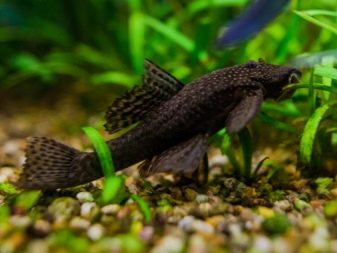
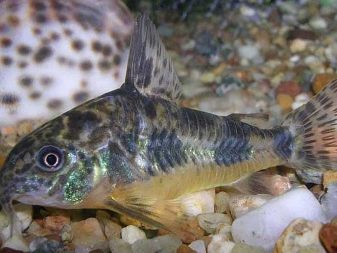
Growing conditions
To maintain a beautiful appearance and activity, experts recommend placing the oranda only in large containers with cold water, the volume of which will be sufficient for free movement. Due to its love for cool water, this species can be settled even in outdoor decorative ponds. To prevent the death of aquatic inhabitants and the appearance of various diseases in them, experts recommend regularly changing and filtering the water.
Consider the basic rules for the care and maintenance of the oranda, which will maximize the life of pets and get healthy offspring:
- mandatory installation of a filtration system that will effectively purify water;
- constant saturation of water with oxygen;
- weekly renewal of at least 35% of water;
- the presence of rolled soil or river sand;
- compliance with the temperature level in the range from +18 to +22 degrees;
- maintaining acidity at 8;
- the presence of bright lighting;
- keeping the level of hardness at around 16.
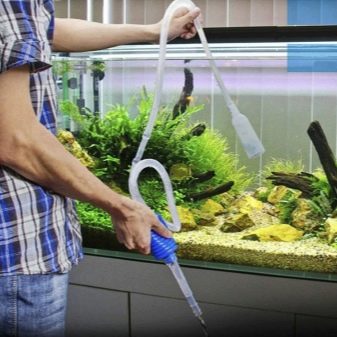
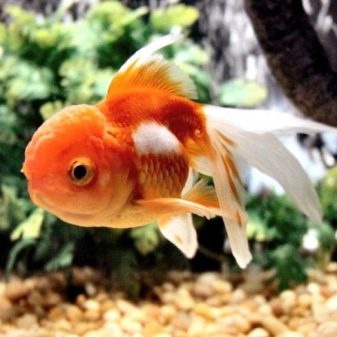
In favorable living conditions, bright growths tend to grow constantly, which can provoke blindness. Experts recommend cutting off excess body fat. This procedure will not cause problems for the fish and will greatly facilitate its life.
To decorate a home reservoir, you can use the following elements:
- loose soil;
- fine gravel;
- driftwood;
- algae (live and artificial);
- moss.
Experts categorically prohibit the use of sharp interior items, which can provoke the appearance of tears on the body of veiled fish.
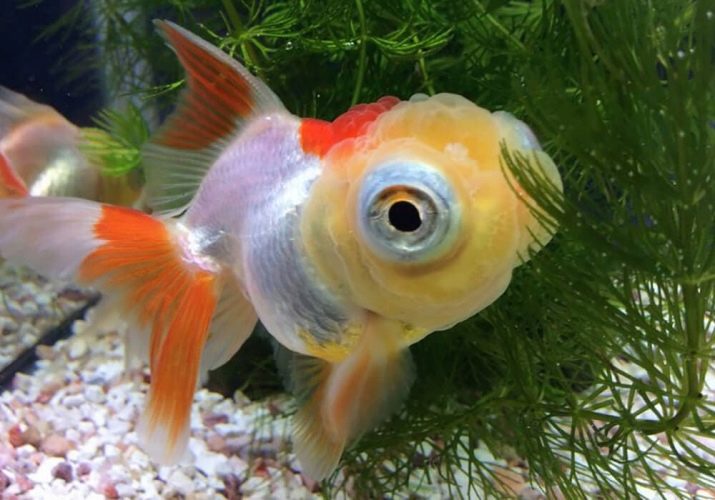
In order for the fish to swim freely, aquarists do not recommend planting a large number of plants in the pond. Algae should only serve for the minimum aesthetic appearance of the pond. When selecting plants, preference should be given to artificial algae or algae with hard and dense leaves that will not be damaged or eaten by fish. This group of living plants includes the following species:
- elodea;
- vallisneria;
- sagittariya;
- kabomba.
The root system of all planted algae must be securely anchored with soil and large stones.
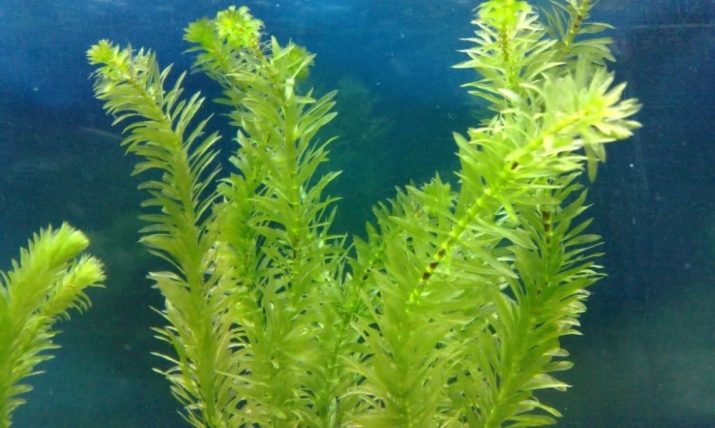
Failure to comply with the rules for growing and caring for fish can provoke the appearance of the following pathologies:
- decay of fins - in case of non-observance of water parameters;
- the appearance of ichthyophthiriosis - low temperature regime of water and the presence of a large number of individuals in one container;
- poisoning (disruption of the digestive system) - poor aeration and poor quality care of the reservoir;
- bladder disease - unbalanced diet.
Feeding rules
The diet of this species can consist of both dry and live food. Oranda has a good appetite and is able to chew constantly. Experts do not recommend overfeeding the pets, and when calculating the volume of the feed mixture, you will have to take into account the total weight of all fish. The amount of feed should be at the level of 3% of the fish weight. The use of more food can provoke not only obesity and disease of fish, but also their death. The main signs of eating excessive amounts of food are the movement of fish on the side.
The ration of fry should consist of two meals a day, but adults should not throw food more than once a day. When the first signs of overfeeding appear, it is necessary to immediately limit the volume and number of feedings, and sometimes even put the pets on a diet.
Pet's favorite vegetable treats are lettuce, spinach, and various vegetable cuts. Live food for fish will be bloodworms, tubifex, daphnia and fresh or frozen worms. To maintain the vitamin and mineral balance, experts recommend using special nutritional complexes for goldfish.
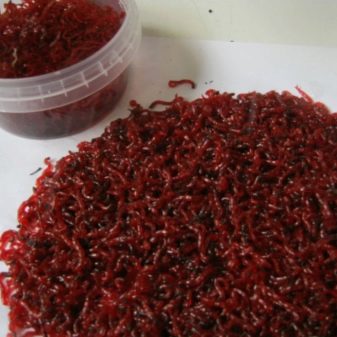

Reproduction
Sexual maturation of males and females occurs at 12 months of age, but professional aquarists recommend mating fish at 2 years of age. The most favorable time for mating is spring. For two females and one male, it is enough to install a spawning box with two sprayers planted with small aquatic plants in the center of the reservoir. The water temperature in the reservoir should not be lower than 24 degrees. Before mating, the female and the male are in different containers for about 14 days, and animal food must necessarily prevail in their diet.
In the most comfortable conditions, one fish is capable of producing up to 10 thousand eggs. To obtain healthy offspring, owners must independently remove pale, cloudy eggs from the nest. After 48 hours, the larvae begin to hatch, and after a week you can see the fry swimming, which go through a natural path of selection. This method assumes the survival of only the strongest and healthiest fry.
The diet of newborn fish should consist of rotifers and live dust. Small pets have yellow growths and a slow growth rate. To provoke reddening of the growths, it is necessary to feed young fish with a special pigmented food and do color injections.
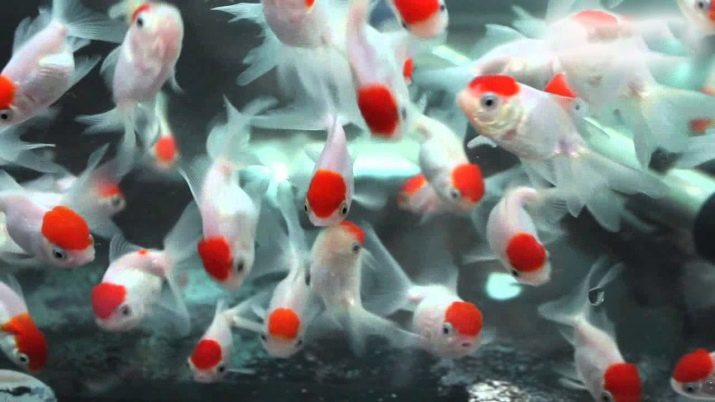
In order to start the breeding process for this type of fish, you need to purchase a certain number of individuals. For a purchase, it is better to go to specialty stores or professional breeders. Experts do not recommend buying fish in spontaneous markets, where sick underwater inhabitants are often sold. Also, novice aquarists should pay attention to the appearance of the sellers and the living conditions of the living creatures.
Any pet is not only a source of a huge amount of positive emotions and positivity, but also an object of constant care and attention. Many residents of large cities do not have the opportunity to have cats and dogs due to the need to pay a lot of attention and time to them, therefore they prefer plants and fish, thinking that caring for an aquarium will not require a lot of time and will not cause difficulties. This opinion is erroneous and does not correspond to reality.
Before starting the arrangement of a home reservoir, it is necessary to carefully study all the intricacies of caring for it so that such an acquisition does not become a burden and unnecessary purchase.
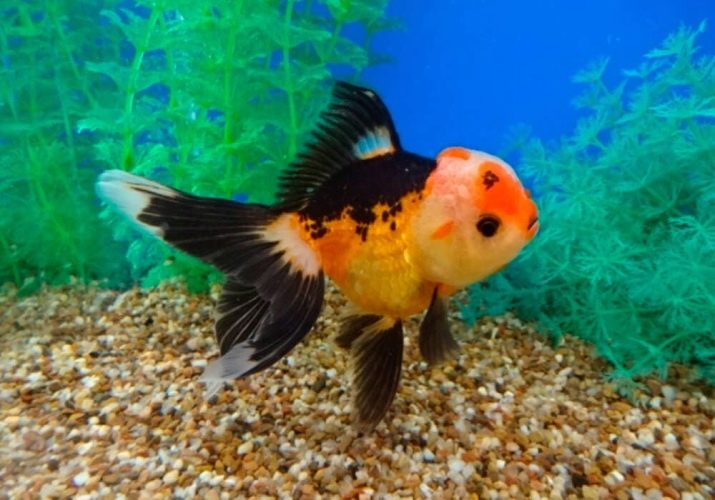
For more information about the features of these fish, see the next video.








